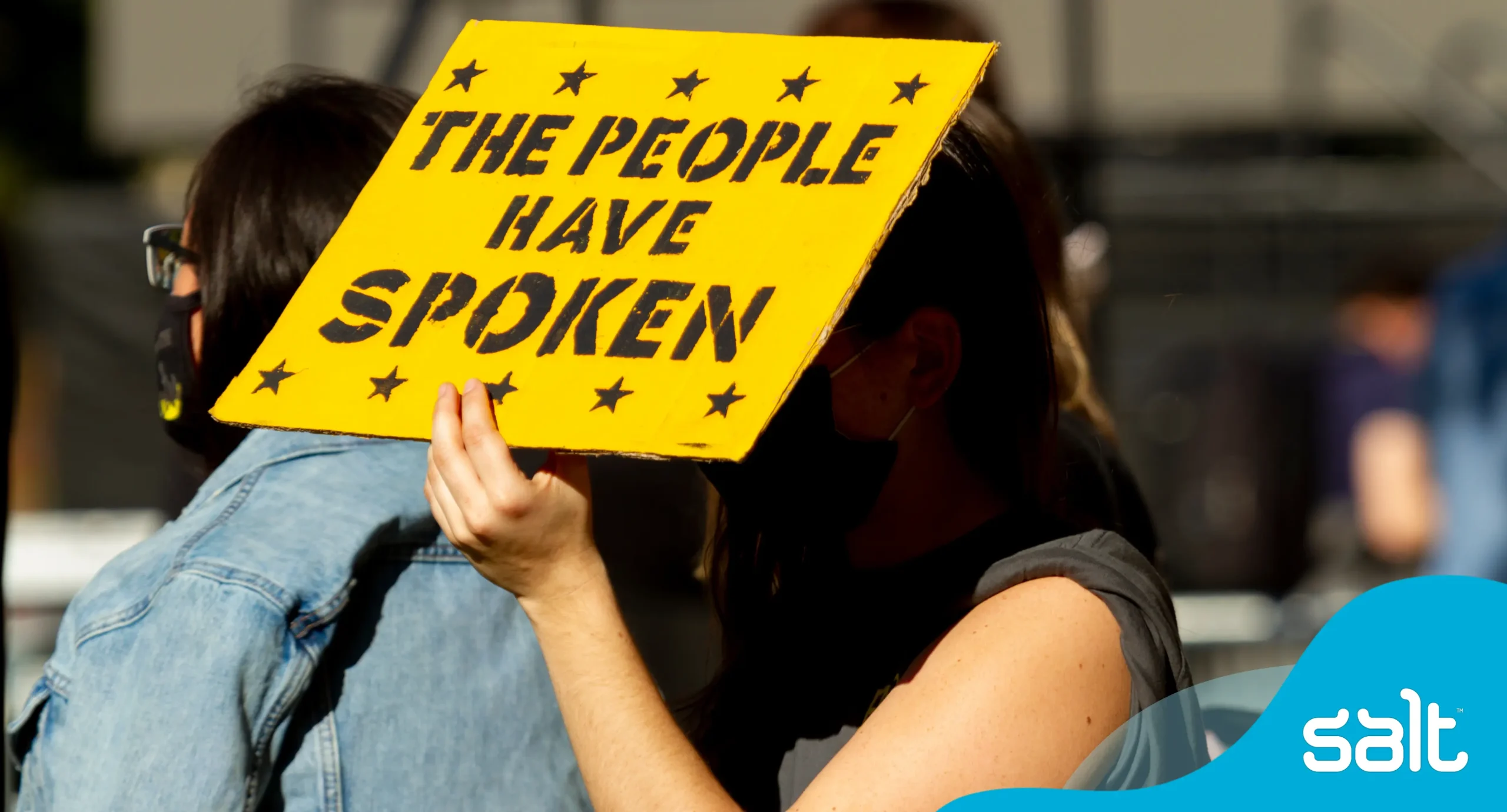
The gender equity conversation has reached a critical moment. For years, women have been told to “lean in” and work twice as hard to break glass ceilings. But our 2025 poll results suggest the system still isn’t leaning back:
- Only 51% of our survey respondents feel their workplace is fully inclusive for women.
- 42% say company culture is the biggest challenge for women career progression.
- Just 18% actively speak out against discrimination.
So, what are workplaces doing, and are we all doing enough to make a change?
Note: This year, Salt conducted a series of Women at Work polls to explore three key areas for women in the workplace: career progression, workplace inclusivity, and allyship. Based on the results from our communities, we have gathered insights and reflections on how to support women in the workplace. We recognise that gender is complex. When we use ‘women,’ we aim to include all who identify with womanhood, including transgender women and some nonbinary individuals.
Women’s career progression: it’s a systemic roadblock
Despite years of effort to promote gender equity, women’s career progression continues to hit systemic roadblocks. The progress made is often fragile, with real, impactful changes at risk. How solid are workplace plans, processes, and systems? Are outdated leadership norms, unconscious bias, and a lack of true sponsorship preventing women from advancing?
“True equity isn’t just about opportunity. It’s about intention. Companies must be brave enough to break their own patterns,” – Thabile Ntlatleng, Productivity and Development Consultant, Salt AEMEA
What are the three biggest challenges for women to progress in their careers?
Company Culture: The #1 barrier for women, say 42%
When women identify the barrier to career progression as culture, the question is, what does that mean? Workplace culture can refer to leadership styles, how decisions are made, what behaviours are rewarded, and unwritten rules of social interactions. According to our article on why company culture matter, culture can make or break career growth. If culture is the issue, then companies must be willing to diagnose exactly which parts are holding back and address them head-on.
21% say promotion carriers are stalling women’s careers
The “broken rung” phenomenon continues to limit women’s advancement, particularly from entry-level to managerial positions. Women are less likely to be promoted to first-level management roles, which creates a ripple effect throughout their careers. Without clear, structured pathways for progression, women must constantly work harder just to be considered.
20% say unequal pay is still blocking progress
Gender pay gaps remain a glaring issue. Women are still reported to routinely be offered lower initial salaries and continue to have less access to high-impact projects that can accelerate career growth and compensation. Worse, organisations that lack pay transparency continue to reinforce these disparities, preferring to keep compensation details hidden rather than tackling inequality head-on. This will continue to remain an issue for as long as companies choose not to have transparent compensation policies.
The reality of workplace inclusivity
The illusion of inclusivity is one of the most harmful aspects of today’s workplace landscape. While companies and employees claim to champion diversity, equity, inclusion, and belonging, our poll results reveal a different reality. The experiences of women in the workplace are vastly different from what most companies believe they are offering.
“Inclusivity occurs inside and outside the office; in the office, stand up for each other to ensure all voices are heard, not just the most dominant ones. Outside the office, consider how you may be able to provide practical assistance – for example, running or facilitating errands if a colleague’s in a tight spot or sharing childcare if a colleague needs to get to an important meeting.” – Leanne Cogswell, Practice Lead, Salt New Zealand
How inclusive are workplaces for women?
Inclusion? Just 50% believe their workplace measures up
But what does “fully inclusive” really mean? Many organisations boast extensive DEIB policies, but very few of them are proactively enforced and widely promoted. When disparities appear in promotions, pay, and access to senior roles, alarm bells should be ringing.
27% say their workplace is only “somewhat inclusive”
Just over a quarter of respondents feel that their work environments are “somewhat inclusive”. This indicates that while policies and programmes for inclusivity exist, they may be superficial or fall short in execution or enforcement.
17% feel their workplace is “not really” and 6% “not at all” inclusive
Almost a quarter (23% combined) of respondents say that their workplace is not inclusive. These environments are often characterised by outdated cultures, a lack of clear policies on gender equity and biases that remain unaddressed. This level of exclusion signifies that companies are failing to address fundamental issues that prevent women from thriving at work.
From passive to active allyship
The phrase “I’m an ally” is common. But if allyship is widespread, why are women still struggling for recognition? Passive, reactive allyship is holding women back.
“True allyship means amplifying women’s voices, advocating for equal opportunities, supporting flexible work policies, and calling out bias. Practical steps like mentorship, sponsorship, and insisting on inclusive environments help create workplaces where women can truly thrive.” – Rachel Hamilton, Senior Consultant, Salt New Zealand
What are the most common actions being taken to support women in the workplace?
46% say supporting female careers is their key focus as a workplace ally
While many respondents claim to support women’s careers, comparing the results from women themselves highlights a desire for more proactive action. True advocacy involves promoting women, developing them for leadership and recommending them for high-impact projects. Along with making sure they have a seat at the table.
21% say they support women by listening to their experiences
Listening is crucial, and many allies are already making important efforts. However, to make a real difference, this listening must also translate into meaningful and tangible changes. Women appreciate the support but are eager for more than just conversations, they are looking for allies to help drive real, visible action.
Speaking out against discrimination: Just 18% of allies take this step
Less than 19% of respondents selected that they speak up against bias and discrimination when they see or hear it, as a key way to being an ally at work and home. Current organisational cultures have created environments where allies and the employee population at large fears professional repercussions and social discomfort for calling out workplace discrimination. This environment allows harmful patterns and bias to fester.
Getting proactive, not passive with allyship in the workplace
Our polls have revealed that there is a desire to move beyond listening and encouraging. To focus more on supporters who sponsor career advancement, demand pay parity, and ensure women are fairly considered for leadership opportunities.
Importantly, creating an inclusive culture is not only the responsibility of leadership or companies; but every individual also plays a vital role. For example, when a woman (or anyone for that matter) shares an idea in a meeting and it’s overlooked or dismissed, but then later the same idea is praised when repeated by another colleague. If no peer steps in to acknowledge the original contribution or call out the oversight, it perpetuates a cycle of unspoken discrimination.
Similarly, when an ally challenges a workplace joke or comment that perpetuates stereotypes, they set an example, empowering others to do the same. If companies create a safe environment for confronting bias, employees should feel that they company encourages and supports them when speaking up against discrimination. This also means that victims and their advocates are supported, and perpetrators face repercussions.
What needs to change for workplace inclusivity?
Many women face unspoken biases that shape their career progression, from outdated leadership expectations to informal networks that exclude them. Companies must examine whether they truly support inclusion or if barriers remain.
When thinking about workplace inclusivity, it’s more than just policies. For example, making parental leave and flexible work the starting point for supporting women is outdated. These are baseline policies, not equity solutions. Real progress means designing career paths that don’t penalise caregiving, with structured reintegration plans, clear promotion pathways, and a culture that values performance.
Addressing unconscious bias in the workplace is also crucial. But training alone won’t fix bias. Addressing unconscious bias requires more than a workshop. It demands accountability. Leaders need outcome-driven frameworks, not just awareness sessions. A start can be turning DEI policies into real practices, backed by data and measurable impact. Because if you’re not tracking change, you’re not making any. From aspiration to reality: a roadmap for real change
Performative actions are not enough. Companies must adopt intentional changes to ensure gender equity is embedded into every policy, promotion, and paycheck. Until organisations commit to these steps, inclusivity will remain more aspiration than reality.
Our data makes one thing clear: while people and companies are eager to be seen as allies, collectively we are failing to take the necessary steps to create real, tangible inclusivity. This transformation to action requires commitment, accountability, and a personal extreme willingness to confront uncomfortable truths about ourselves, our beliefs, and the way we operate in and lead businesses.
Women are done simply sitting and leaning in. It’s time to move from intention to action.


